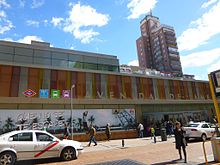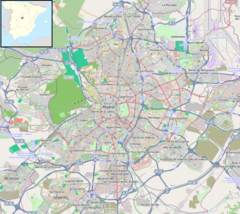Avenida de América (Madrid Metro)
| Madrid Metro station | ||||||||||||||||||||||||||
 Line 9 platform, Avenida de América | ||||||||||||||||||||||||||
| General information | ||||||||||||||||||||||||||
| Location | Chamartín / Salamanca, Madrid Spain | |||||||||||||||||||||||||
| Coordinates | 40°26′17″N 3°40′36″W / 40.438035°N 3.6766893°W | |||||||||||||||||||||||||
| Owned by | CRTM | |||||||||||||||||||||||||
| Operated by | CRTM | |||||||||||||||||||||||||
| Construction | ||||||||||||||||||||||||||
| Structure type | Underground | |||||||||||||||||||||||||
| Accessible | Bus terminal only; accessibility to rest of station planned | |||||||||||||||||||||||||
| Other information | ||||||||||||||||||||||||||
| Fare zone | A | |||||||||||||||||||||||||
| History | ||||||||||||||||||||||||||
| Opened | 26 March 1973 | |||||||||||||||||||||||||
| Services | ||||||||||||||||||||||||||
| ||||||||||||||||||||||||||
| ||||||||||||||||||||||||||
Avenida de América ([aβeˈniða ðe aˈmeɾika]; "Avenue of the Americas") is a multimodal station in Madrid, Spain that services Madrid Metro Line 4, Line 6, Line 7, and Line 9, as well as city buses and intercity and long-distance coaches. Between 1986 and 1996, it also served Line 8. The station is located below the intersections of Avenida de América and Francisco Silvela and Príncipe de Vergara streets. The station consists of several underground levels, with the bus terminal located in the upper three and the Metro station located in the lower four. It serves the neighborhood of Prosperidad and El Viso in Chamartín district and La Guindalera in Salamanca district. It is about 15 minutes from Madrid Barajas Airport and 10 minutes from the city centre of Madrid.[1][2][3][4]
History
Madrid Metro station
The station was inaugurated on 26 March 1973 when Line 4 was extended from Diego de León to Alfonso XIII. The metro station was built from the start to service four Metro lines, and each platform was opened to the public when the corresponding line went into service. The Line 4 platforms are the shallowest in the Metro station, located at the fourth level below the street and aligned with Francisco Silvela street.
On 17 March 1975, Line 7 was extended to Avenida de América.[5][6] The Line 7 platforms are the second shallowest in the Metro station, and are arranged in a Spanish solution layout with one central platform and two side platforms.
Four years later, on 10 October 1979, the Line 6 platforms entered service when the first stretch of Line 6 was inaugurated between Pacífico and Cuatro Caminos.[7] Like the Line 7 platforms, it features a central platform and side platforms.
Another four years later, on 30 December 1983, a segment of Line 9 known as Line 9B was built, connecting Avenida de América to Plaza de Castilla. This segment was not connected to the rest of Line 9 until 24 February 1986, when the stretch from Avenida de América to Sainz de Baranda was built. The Line 9 platforms are the deepest in the station.
On 23 December 1986, service on the old Line 8 began between Avenida de América and Nuevos Ministerios using the existing Line 7 tunnel, so that each line used one track. When Line 8 and Line 10 were merged in 1996, Line 8 service ended at Avenida de América, and in 1998 Line 7 resumed the use of both tracks.
In recent years, the Line 6 and Line 4 platforms have undergone renovations. The Line 7 platforms were temporarily closed during September 2006 in order to replace the catenaries.
Bus terminal

At the end of the 1990s, a three-level underground bus station was built above the metro station in the area previously used the Metro station vestibule. The station, which was the second underground bus station to be built in Madrid, was completed in 2000. It services city buses as well as interurban and long-distance coaches, and it houses stores and a parking garage.
Between 2009 and 2014, the second level of the bus station underwent renovations.
Station layout
| 0 | Street level | Exits/entrances |
| -1 | Upper mezzanine | Bus terminal gates 20–36 (long-distance buses) |
| -2 | Center mezzanine | Bus terminal gates 1–19 (urban/suburban buses) |
| -3 | Metro mezzanine | One-way fare gates, ticket machines, station agent Transfer between platforms (Lowest level served by lifts; platforms not handicapped accessible) |
| -4 Line 4 platforms |
Side platform, doors will open on the left | |
| Eastbound | → | |
| Westbound | ← | |
| Side platform, doors will open on the left | ||
| -5 Line 7 platforms |
Side platform, doors will open on the left | |
| Eastbound | → | |
| Island platform, doors will open on the right for alighting passengers only | ||
| Westbound | ← | |
| Side platform, doors will open on the left | ||
| -6 Line 6 platforms |
Side platform, doors will open on the left | |
| Track 2 | → | |
| Island platform, doors will open on the right for alighting passengers only | ||
| Track 1 | ← | |
| Side platform, doors will open on the left | ||
| -7 Line 9 platforms |
Side platform, doors will open on the left | |
| Southbound | → | |
| Northbound | ← | |
| Side platform, doors will open on the left | ||
References
- ^ "Línea 4". Metro de Madrid. Retrieved 21 March 2020.
- ^ "Línea 6 Circular". Metro de Madrid. Retrieved 5 September 2019.
- ^ "Línea 7". Metro de Madrid. Retrieved 5 September 2019.
- ^ "Línea 9". Metro de Madrid. Retrieved 1 August 2019.
- ^ "Nueva línea de Metro" [New Metro line]. ABC (in Spanish). 15 March 1975. Retrieved 4 December 2014.
- ^ "La línea séptima del Metro ya enlaza Pueblo Nuevo con la Avenida de América" [Metro Line 7 now connects Pueblo Nuevo to Avenida de América]. ABC (in Spanish). 18 March 1975. Retrieved 4 December 2014.
- ^ "El Rey inauguró la nueva línea de Metro entre Pacífico y Cuatro Caminos" [King inaugurates new Metro line between Pacífico and Cuatro Caminos]. El País (in Spanish). 11 October 1979. Retrieved 7 March 2014.

